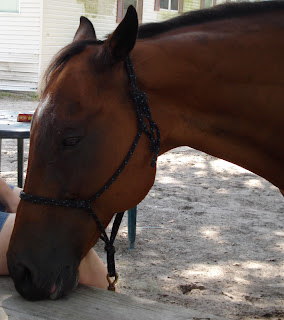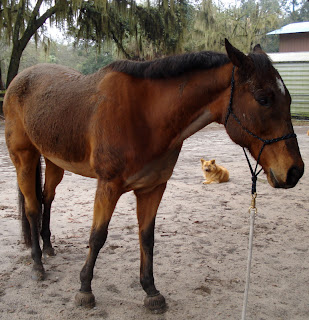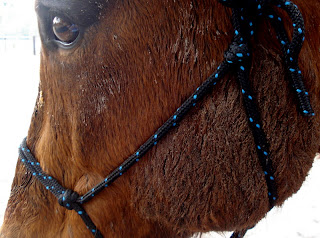My brain is shooting off every which way today—so you’re going to get that kind of blog post: a hodge podge of thoughts and information. Often times I clear my head by talking or writing things out, so here goes. (Thanks for putting up with me.)
 |
| Pat Parelli and friends |
 |
| Para-Olympian Lauren Barwick |
 |
| Lauren is paralyzed from the waist down |
 |
| Playing the Sideways Game at liberty (with no lead rope) |
 |
| Linda Parelli with Hot Jazz |
Twice on Wednesday I found myself talking to someone about
how lucky I am. The first time, I was sitting on the back of my horse, talking
to my friend and trainer, Gayle, about how my experience with Tank has been one
of the best things in my whole life. We talked about how lucky I feel first to
even own a horse, and also to have one that I’ve been able to bond with so
closely. I mentioned that my life is so much better than I ever imagined it
being. Though I was speaking out of the emotion of the moment, glossing over
the pain and emotional storms I’ve weathered, it is true that I am lucky. If I
started to list the struggles and problems of my life, that lucky feeling would
certainly fade. It was then that I realized it’s my choice what version of my life to dwell on, and ultimately my
choice whether I feel “lucky” or not.
 |
| Lucky doing what he does best |
The craziness continues, but it’s good craziness.
So what’s new with you?
 |
| Hey, that's my tongue! |
 |
| Zzzzzz... |
 |
| Back to normal. |
Have you been watching the Olympics? I’ve been spending
hours glued to the TV because…equestrian events! Thank you NBC Sports! So far
they’ve had the sense to air good portions of the three equestrian events that
take place at the Games: eventing, dressage and show jumping. If you’ve never
watched equestrian events, here’s a quick primer for what you can see, and a
few fun facts:
 |
| Me and Tank |
You can also develop a great strength training program with horses. Aside from the obvious hauling of hay or bags of feed, or shoveling manure, there’s always carrying your saddle (especially if it’s a western saddle—those things are heavy!), or attempting to hold up your horse as he leans on you while you clean his feet. Posting a trot and riding without stirrups are excellent exercises for the thigh muscles as well.
Don’t forget the fitness benefits of relaxation. Being around a horse, at least for me, provides a way to lower my blood pressure. Just looking at horses, stroking their soft coats and smelling that warm barn smell makes me feel calmer.
By all rights, I should be a lot thinner than I am after burning all those calories at the barn. (Maybe it has something to do with the chocolate one of my barn buddies gave me…hmm…)
Have you found any unusual ways to get fit?
 |
| Pet, friend, therapist, and now personal trainer? |
Humans first prized horses for their strength and speed, but we have since been captivated by their beauty, their deep eyes and mysterious silences. Here’s a poem by Robert Wrigley, who lives in
After a Rainstorm
Because I have come to the fence at night,
the horses arrive also from their ancient stable.
They let me stroke their long faces, and I note
in the light of the now-merging moon
how they, a Morgan and a Quarter, have been
by shake-guttered raindrops
spotted around their rumps and thus made
Appaloosas, the ancestral horses of this place.
Maybe because it is night, they are nervous,
or maybe because they too sense
what they have become, they seem
to be waiting for me to say something
to whatever ancient spirits might still abide here,
that they might awaken from this strange dream,
in which there are fences and stables and a man
who doesn’t know a single word they understand.
I'm sure you won't have any trouble recognizing why I liked this poem...
I’m not particularly patient. I want to get things done, and I want them done Right Now. However, especially with a horse, I’ve learned that some things absolutely cannot be rushed. They take the time they take, and you’ll be much less frustrated, not to mention safer, if you relax—and sometimes throw out entirely—your expectations. For me, when I’m learning something new (or teaching Tank something new), things go better when I take baby steps. Sometimes to my embarrassment, I’ve become the poster child for baby steps at my barn as my trainer often uses me as an example of someone who takes things slowly. I am not naturally athletic, and frankly, I’m also a big chicken, so yes, I do take things slowly. When I take a step forward too quickly, I often end up taking two steps back. What works for me in riding is breaking down every new skill into small parts, then practicing those parts until I feel completely comfortable with them. Then I can move on.
Baby steps work great for other pursuits, too: cleaning and reorganizing the house, learning to draw and paint, changing diet and exercise habits and so on. The beauty of baby steps is that if each small step is solid, you’ll find yourself making steady progress. You’ll be less likely to stagger forward then backward in fits and starts. In this way, you will go slower to go faster.
Of course, this is what works for me. Each person has his or her own best method for personal growth—my baby steps may drive some people absolutely mad with frustration. This is where you must listen to your heart for direction. What works for me may not work for you, and vice versa, so please ignore this advice if you’re more like a hare than a tortoise. Few things make me crazier than to have someone tell me my way is wrong and I should do things differently!
Sometimes I get frustrated, and wish I could progress a bit faster than I do and I have to remind myself that it takes the time it takes. Overall, this slow and steady method works for me. It works for Tank, who gets anxious when he’s not sure what he’s being asked to do. We plod along, tortoise-like, but we’re going forward. And that’s what matters.
 |
| Just so you know, this is not a self-portrait... |
We obviously don’t celebrate the horses’ birthdays for the horses. We do it because we look for excuses to celebrate, to share food (because there is yummy food for humans at these parties, too) and laughter. It’s one of my favorite simple pleasures.
How did you celebrate today?
I had a couple of blog post possibilities in the works for today--but after I arrived at the barn this morning to find this:
And he still had his breakfast on his face (the brown stuff on his nose is bran mash).
Fortunately, it was warm enough today to hose him off instead of curry and brush all that mud and sand off him.
 |
| At work on Tank's tail--a two-person job |
 |
| Pitiful forelock |
 |
| Are you sure we have to do this? |
Tie up horse, and even though he’s still a little damp, you optimistically think there are some areas dry enough to start on. Begin clipping. Keep even pressure on the clippers so you have no gouged spots. Some people clip the legs first because they’re more technical (and ticklish) and it’s good to do them when you and the horse are fresh and your clipper blades are sharp. Some people start on the face. I personally like to see immediate progress, so I start somewhere I can see inroads, like the neck, chest or hindquarters. I also skip around when I get tired of working on one area, so my horse looks like nothing on earth until he’s completely done.
 |
| Making inroads |
Horse hair sticks to everything, so when you are done, you will be covered from head to foot with little pieces of hair. In fact, YOU will look like you need clipping. Turn your horse out or put him in his stall and offer him treats for being such a good boy. Go home, take a shower, pour yourself your adult beverage of choice and inform the family that dinner will come from the nearest pizza place that delivers.
 |
| The finished tail |
P.S. I have to go back this weekend and clean up a few areas--I'll post a picture of the finished product at that time. Stay tuned!
 |
| Ouch. |
As I lay in bed the night after the fall from the horse, evaluating what hurt and what didn’t, the thought occurred to me that falls are pretty much inevitable. (As one T-shirt I’ve seen proclaims, “The hardest thing about horseback riding is the ground.”) I don’t think much about falling off, I always wear my riding helmet, and I’m a careful rider. My horse is gentle, obedient and generally quite mellow, though like most horses, he will occasionally spook. You can minimize risk, but if you ride regularly, it’s pretty much not a matter of if you will come off the horse, but a matter of when.
That’s true of life, too, isn’t it? There’s risk in everything—driving to the grocery store, riding bikes with the kids, even eating bagged salad! If you thought too long and hard about what might happen, you wouldn’t be able to leave your home.
Falls in life are inevitable, just like they are in horseback riding. All you can do is minimize risk. Buckle your seat belt, wear your helmet, thoroughly wash the greens...live your life.
(But I especially recommend wearing your helmet.)



































